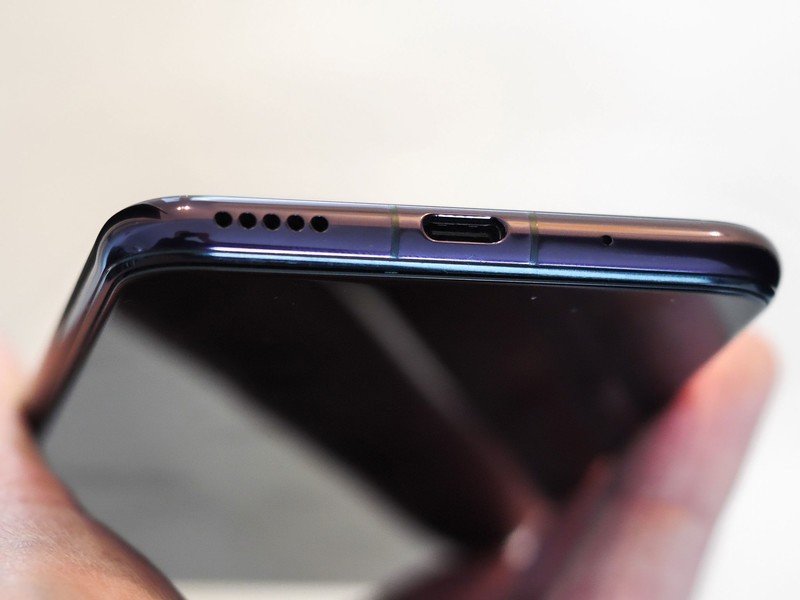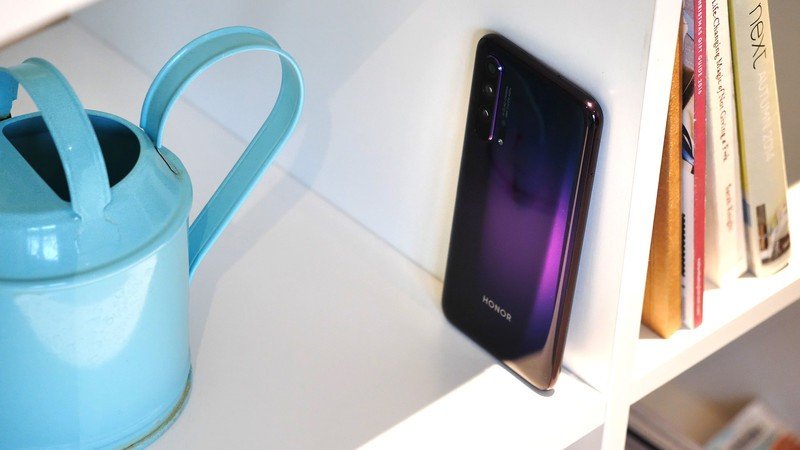Honor 20 Pro review: Gunning for the big-name flagships

The affordable flagship space is more competitive than ever, with recent entrants from OnePlus and Oppo making headlines in Europe. And so Huawei's Honor sub-brand, which was already well positioned with its View 20, is back this spring with three new phones in the Honor 20 series.
Leading the charge is the Honor 20 Pro, which I've been using for the past couple of weeks -- a device which stays true to the legacy of earlier mainline Honor phones, while packing in important spec upgrades to stay ahead of the curve.
Pros:
- Gorgeous chassis design
- Fast performance + high-end specs
- Epic battery life
- A fingerprint scanner that actually works
- Flagship-tier cameras
Cons:
- No water resistance
- Bad, mushy haptic motor
- Magic UI is a rebadged EMUI with changed colors
- Super-macro camera is worthless
- Huawei/U.S. drama puts long-term updates in question
A note on Huawei phones, updates, and the U.S. government
Huawei is currently entangled in a U.S. export ban which may limit its ability to update its phones, both Huawei and Honor-branded, to future firmware versions after August 2019. For more information, see this article.

Holographic aurora
Be an expert in 5 minutes
Get the latest news from Android Central, your trusted companion in the world of Android
Hardware and Design
The hardware design of the Honor 20 Pro is a head-on collision between the Honor View 20 and Huawei P30 Pro. Around the front, the brand sticks with an all-screen display, using an IPS LCD panel and a tiny hole-punch selfie camera. On the rear, there's a hefty triple camera module and a gorgeous new "holographic" reflective pattern, formed by layers of colored glass.
I've been using the purple Phantom Black color variant, which is similar to the pattern used in the Honor 10, though more understated. Tilting the phone through the light conjures up aurora borealis-like bolts of color, ranging from deep blue to near pink. The back panel and curved side walls are a little slick, but the phone's relatively compact proportions make it easy to hold onto.



The Honor 20 Pro's 'holographic' back pattern is simply gorgeous.
Unlike the View 20, Honor hasn't managed to fit a 3.5mm headphone jack into the Honor 20 Pro. (Nor is there any dongle in the box, for what that's worth.) However, there's a welcome addition on the right edge of the device — a Galaxy S10e-style capacitive fingerprint scanner, which works flawlessly. That's complemented by speedy face unlock via the hole-punch front camera.
And, for those that still care about controlling a TV, cable box or air conditioner from their phone, there's still an IR blaster up top. (Honor still hasn't given up on that somewhat obscure feature.)
I've found the display, a 6.26-inch Full HD+ IPS LCD panel, to be bright and vibrant, though with the default color temperature a little colder than average. (This is configurable in the display settings.) Daylight visibility, even under the bright summer sun, has been on par with the majority of OLED-based flagships.
The core specs of the Honor 20 Pro mirror those of other high-end Huawei phones of the moment. It's running a Kirin 980 processor, with up to 8GB of RAM and 256GB of storage, plus dual SIM support. And although the footprint of this device is pretty small, it's also fairly chunky, in order to accommodate an ample 4,000mAh battery with Huawei's SuperCharging tech.


The only thing you're missing is water resistance and a decent haptic motor.
Honor has yet to ship a water-resistant flagship, and the 20 Pro is no exception. There's no IP rating, nor is there any seal around the SIM slot. So outside of the occasional rain shower, you'll want to watch this one around water.
The Honor 20 Pro also doesn't include stereo audio, though I've been perfectly happy with the output from the bottom-firing driver.
My biggest hardware disappointment in this device, however, is the extremely mushy, horrible-feeling haptic motor used by Honor, which feels the same as what I've used in just about every Honor phone for the past year. It's nowhere near the tight haptic feedback provided by the OnePlus 7 Pro, to the point where I eventually just turned off all haptic feedback.
Turns out there are some things you still can't do at that lower price point. Overall, though, the Honor 20 Pro packs an extremely competitive spec loadout into an attractive, compact chassis.

It's Magic
Honor 20 Pro Software and Battery Life
The Honor 20 Pro runs Android 9 Pie with Honor's Magic UI 2.1 software, which is another way of saying it runs Huawei's EMUI 9.1 software with a different theme. Honor plans for Magic UI and EMUI to become more differentiated in future, but for the moment they're the same thing with slightly different visuals.
Magic UI is still basically just a rebadged EMUI.
While Magic UI isn't as sleek or attractive as Samsung's One UI or OnePlus's OxygenOS, it's perfectly serviceable, with fast performance and a plentiful feature set. Huawei's full-screen gesture setup allows you to experience what'll be coming to Android Q later this year. And there's extensive theming support through the built-in Huawei Themes app, plus some neat preloaded wallpapers that play with the placement of the hole-punch camera.
Like EMUI, Magic UI borrows several design elements from Apple's iOS, including its folder layout and parts of its animation style. But there are some undeniably Googley influences too. Android Messages, complete with RCS support, spam protection and other goodies, is the default messaging app. And Honor's own apps are predominantly light and bright, with heavy use of whites and blues, and controls near the bottom of the screen where they're easy to reach.

Magic UI also gives you a great deal of control over apps battery usage, particularly in the background. (Like all Huawei phones, though, the frequent power consumption notification alerts can be tiresome.)
In any case, Honor's power management is part of what makes its phones consistently great performers in terms of battery life. In the case of the Honor 20 Pro, that goes hand-in-hand with a large battery capacity of 4,000mAh.
The Honor 20 Pro boasts better battery life than the OnePlus 7 Pro.

That's the same capacity as the OnePlus 7 Pro, however Honor's device manages much better battery life from a similar cell size. Whereas I'd sometimes struggle to get through a full day on the 7 Pro, the Honor 20 Pro never left me with battery anxiety. It broadly matched the battery life I'd seen earlier in the year from the View 20, giving me either a full day of heavy use, or two days of lighter use. On heavier days, it wasn't rare to see six hours of screen-on time with mixed-use indoors and outdoors.
The strong battery performance is backed up by Honor's SuperCharge, which is a rebranded version of the same Huawei SuperCharge spec. This is the 22.5W version, as opposed to the newer and faster 40W standard used in the Mate 20 Pro and P30 Pro, but it's still relatively speedy, and unless you're charging a completely dead battery, you probably won't notice the difference.
It's interesting to note that in the areas of software and battery life, the Honor 20 Pro and its major competitor, the OnePlus 7 Pro, are diametrically opposed. With OnePlus you get a far superior software experience, but occasionally sketchy battery life. With Honor, you'll need to learn to live with Magic UI, but in return live free from battery anxiety.

Almost a P30 Pro
Honor 20 Pro Cameras
The Honor 20 Pro sits directly between the Huawei P30 and the P30 Pro in terms of both optics and camera performance. As such, this is Honor's most capable camera setup to date, building on the impressive performance of the View 20.
The main sensor from that phone, Sony's IMX 586, is also used in the Honor 20 Pro, only now with optical image stabilization, and behind an impressive f/1.4 lens. (No, that's not a typo.) On paper that's better than the OnePlus 7 Pro's camera, and the results I've seen show Honor at least matching the performance of OnePlus's primary shooter.
The main camera shoots 12-megapixel images as standard, using quad bayer pixel binning to turn four pixels on the sensor into one in the finished image. Regardless of lighting conditions, the main camera of the Honor 20 Pro always produced pleasing shots with even exposure, and the optional AI shooting mode adds a touch of flair by bringing out the reds in a sunset, or amping up the saturation in a food pic.


If you want to go completely nuts, the 48-megapixel "ultra clarity" mode from the View 20 is back for insanely detailed pics in daylight, though with the benefits of the improved optics of the Honor 20 Pro's main camera.
Honor's new main camera boasts the same module and OIS as OnePlus, but with an impressive f/1.4 lens.
Honor's dedicated handheld night mode also impresses, conjuring up usable shots even in extremely dim conditions, although I noticed far more grain in pics from Honor's night mode compared to OnePlus's Nightscape and other competitors.
The Honor 20 Pro compliments this with a 16MP f/2.2 ultrawide camera, plus an 8-megapixel f/2.4 3X telephoto with OIS, capable of hybrid zoom up to 5X . Spec nerds, if those numbers sound familiar, it's because they're the same on paper as the ultrawide and telephoto modules from the Mate 20 Pro.

The Honor 20 Pro inherits the Mate 20 Pro's ultrawide and telephoto cams.
Both are excellent additions that take Honor's photographic capabilities a level beyond the brand's earlier efforts. The ultrawide is extremely fun to use, and can be used to take some really unique shots in crowded alleyways or open vistas. And the telephoto reaches beyond the 2X cameras of Samsung and Apple to bring out fine detail in far away subjects or landscapes.
Unlike OnePlus, Honor lets you use its night mode with both the ultrawide and telephoto cameras too, though with a predictable hit to quality due to the optics of both cameras. The same, unfortunately, isn't true of the selfie camera, which is the same competent f/2, 32-megapixel module used in the P30 series.










At the other end of the spectrum, Honor has a 2-megapixel (also not a typo) f/2.4 super-macro camera lurking above its LED flash. This baffling little camera is frustrating to use, and produced consistently poor shots during my time with it. It's fixed focus, and the camera app offers no focus peaking, so focusing is a frustrating hit-and-miss exercise. The best you can hope for is a so-so-looking macro pic that appears grainy even fully zoomed out on the phone's screen.
Outside of that one disappointment, however, this is an impressive camera setup, and likely the best you'll find at Honor's competitive price point.

Take the plunge
The Bottom Line
When you're buying an "affordable" flagship phone in 2019, there are fewer compromises than ever. It used to be that the camera was the one thing guaranteed to suck in a phone that wasn't charging top dollar. The Honor 20 Pro is the best argument against that trend we've thus far seen. Compared to a $1000 flagship like the Huawei P30 Pro, all you're missing on the camera side is super-telephoto zoom and extreme low light performance. Outside of those two niche areas, the Honor 20 Pro goes toe-to-toe with its more expensive sibling.

Nevertheless, some other compromises do remain. The haptic motor is garbage, as I've said previously. (Seriously, if you buy this phone, just disable vibration feedback altogether.) And the lack of water resistance — even weasley, OnePlus-style, kinda-but-not-really water resistance — is also unfortunate.
Elsewhere, Honor's fundamentals are strong, with fast performance, a beautiful physical design -- particularly the "holographic" rear pattern -- and exceptional battery life.
4 out of 5
But as we mentioned at the top of this review, there's another reason you may want to skip on an Honor phone right now -- the parent company's ongoing drama with the U.S. government. There are very real question marks about future support for Huawei and Honor phones. And if you decided that, with all the uncertainty right now, to wait and see on any Huawei or Honor phones, I couldn't blame you.
If you do take the plunge, you'll find in the Honor 20 Pro one of the best affordable Android flagships of the year. Let's just hope the same is true in a few months time.

Alex was with Android Central for over a decade, producing written and video content for the site, and served as global Executive Editor from 2016 to 2022.
